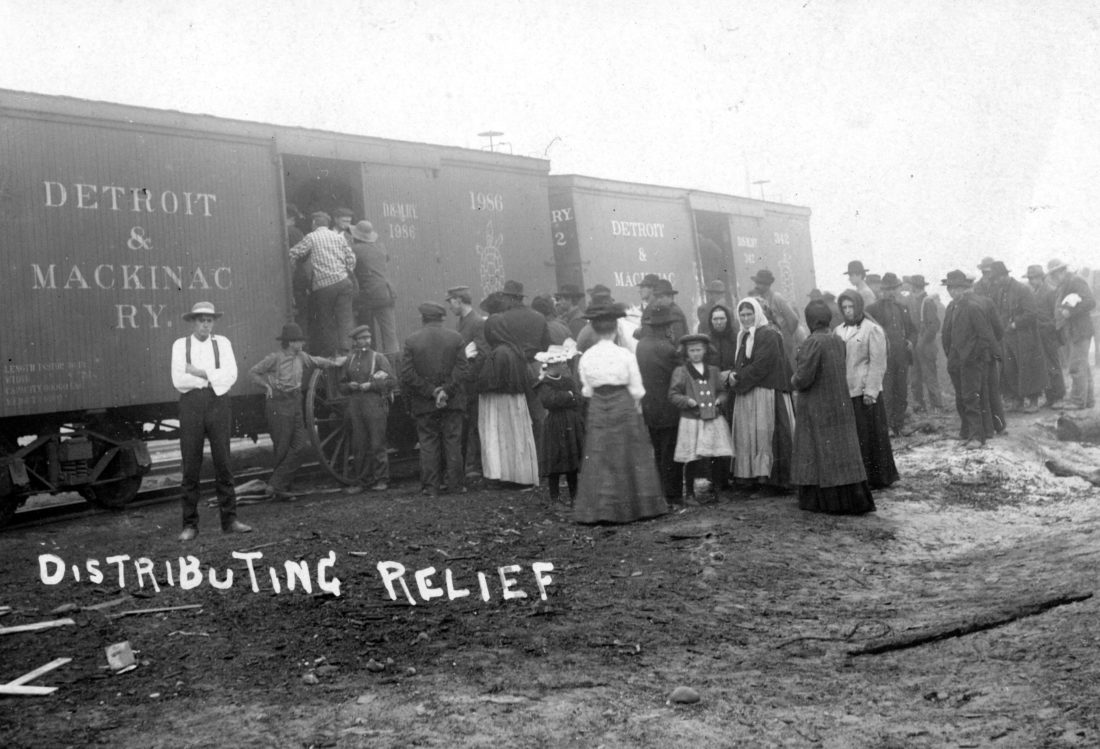The day Presque Isle County burned
110 years ago, the Metz Fire scorched Northeast Michigan

Courtesy Photos This 1908 photo provided by the Presque Isle County Historical Museum shows relief supplies being distributed to needy victims of the fire that left 84 of 110 families in Metz Township homeless. The first load of donated supplies to reach Metz was from the people of the wealthy Detroit suburb of Grosse Pointe.
EDITOR’s NOTE: Today marks the 110th anniversary of the massive Metz Fire. Historic, as one of Michigan’s largest land fires, scores of people perished, along with hundreds of structures, as well as livestock and thousands of acres. What follows is a recounting of this fire and the aftermath.
METZ TOWNSHIP — In 1900, Presque Isle County had 8,821 residents. By 1910, the county’s population stood at 11,229.
The county centered on farming and livestock, a growing limestone mining industry, as well as lumbering and sawmills. On the latter, wood products varied from building materials to kitchen utensils to broom handles to vehicle tire rims and steering wheels.
The spring and early summer of 1908 were exceptionally wet and rainy. By late summer and fall, however, most of Northeast Michigan became dry, the forest floor covered by fallen trees and branches, dry leaves, pine needles, and withering plants.
There are a number of theories on how the fire began: a tossed cigarette, lightning strike, spontaneous combustion from a sawdust pile, or spark from a passing train. The most probable cause was that Millersburg workers were clearing brush from a large swath of cleared land.
The winds were intense, capturing the brush fire and taking it on a 31-plus-mile trek to the Lake Huron shores. The blaze was well over three miles wide.
The Oct. 22, 1908 edition of The Alpena News reported that Martin Lapczinsky, his wife, and two children rushed into a boat on Grand Lake to avoid being engulfed by eastbound flames. After moving multiple times in their boat, they reached the mainland, where they sought refuge in a cottage. Believed by some to be an entire deceased family, they instead emerged a week later.
A sudden wind shift reversed the fire westward toward Metz, a village and region of 600 families. The village offered three general stores, three hotels, a boarding house, wooden shingle mill, a sawmill, livery stables, blacksmith shop, three saloons, post office, train station, several houses of worship and family residences and barns.
Metz was noted for farming and sawmill production. The village was served by the Detroit and Mackinac Railway, which offered daily service to Alpena and Cheboygan. Because storage space was limited near the sawmill, logs, posts, rail ties and finished and unfinished construction lumber were stored near the rail tracks.
Word worked its way to town that the roaring fire was headed directly inland.
As the winds intensified, the village of Metz was at the epicenter.
A Detroit and Mackinac representative urgently called for a train to be dispatched to Metz. Residents began to assemble precious possessions — trunks, furniture, beds, a few animals — and, allegedly, a saloon’s stock of liquor — near the train station’s railbed.
As sunset approached, the train arrived, comprised of a steam locomotive, coal car, a variety of rail cars, and a gondola car (a steel, open, flat car with sides).
The train was quickly loaded with possessions on all the cars and up to 40 men, women, and children onto the gondola car.
Night had arrived, but the sky was lit-up with flames and burning embers. The locomotive’s engineer moved forward, traveling through a mass of flames, heat, and smoke.
Two miles south of Metz, the train reached Nowicki’s landing, which was surrounded by finished lumber products and related uncut product. The fire was so intense, it melted and shifted the rails and burned the wooden ties. The derailed engine tumbled on its side with flames, heat, and smoke surrounding the train on all sides.
Passengers began to leap from the gondola car. News accounts offered survivors hearing the screams and smelling the burning flesh of those who died. The derailed locomotive was partially melted and the rail cars were consumed by the fire.
Those who escaped crawled into plowed fields, many with massive burns and related injuries. Miraculously, a few others crawled miles away to Posen.
One of the locomotive’s operators sought refuge in a nearby water storage tank, where he literally was boiled alive.
Based upon what remains could be found, as well as list of missing, it is believed up to 25 perished in Metz and at the derailed train site. Mostly women and children.
Meanwhile, the fire reached Alpena’s outskirts and threatened Rogers City.
Various accounts state the fire continued to smolder well into the late October snowfall and ice forming on Lake Huron near the Presque Isle lighthouse.
In the following days, news accounts of the inferno spread across Michigan and the nation. Clothing, shoes, bedding, furniture, food, livestock and feed began to arrive in the region. The Detroit and Mackinac Railroad Company constructed basic housing for those who had lost their homes.
One clothing shipment arrived from wealthy Grosse Pointe residents. Photos showed Presque Isle women and children adorned in perhaps the finest attire they ever owned.
A State of Michigan historic marker denotes the fire at Route 441 and Railroad Street, near where the prosperous Metz once stood.
Jeffrey D. Brasie is a former Alpena resident. He is a retired health care CEO.
Metz Fire statistics
∫ Recognized as one of Michigan’s most significant land fires.
∫ A known 42 people perished.
∫ 200,000 acres were totally consumed, an area the size of the cities of Detroit, Denver and Saginaw combined.
∫ 1,360 families lost all or partial possessions.
∫ 1,851 adults and children were affected at multiple levels by the fire.
∫ 4,615 individuals received support from the State Fire Relief Commission.
∫ The inferno continued to burn well into October’s end.






